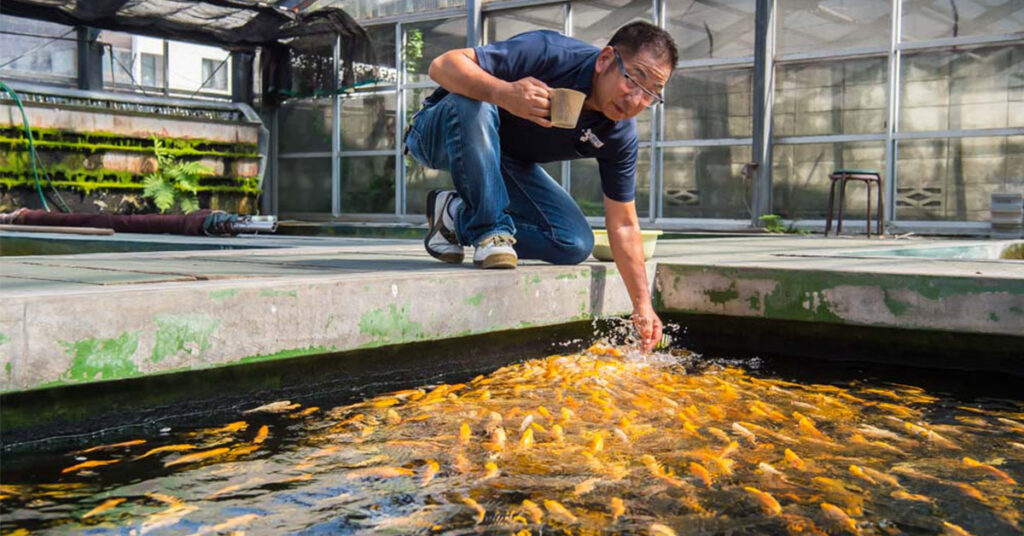
Rule #1: You must go home every day to feed your Koi at lunch.
Just kidding! In a perfect world, we would all be at the pond, practicing ideal Koi feeding practices, feeding our Koi multiple times a day to mimic their eating habits in nature. Sadly, most of us do not have this luxury…
Above all, correct feeding, following Japanese koi feeding techniques, and choosing the right Koi fish nutrition are the key ingredients to improving your Koi’s health, happiness, and longevity. While we recommend auto feeders and will tell you more in this article, it is important that you still do light hand feeding daily!
Automatic feeding technology has made the Koi hobby more fun, but remember that providing an optimal koi diet is just as important as fun!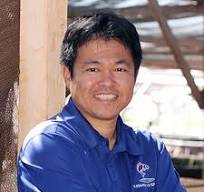
My name is Taro Kodama, and here at Kodama Koi Farm, for over 50 years my family has learned and incorporated many Japanese Koi breeding best practices into our farm from Niigata in order to nurture their maximum growth, color, and health through thoughtful feeding and attention to Koi health and growth.
This blog is about how you feed a proper diet for creating the most beautiful living jewels with the least stress.
Koi Food Seminar Video Part 2 – Our Feeding Process and What We Feed
Koi Feeding Content
- What do Koi Fish eat Naturally?
- What Influences Koi Diet?
- How Much do I Feed my Koi?
- When Should I use an Auto Feeder?
- What are the Benefits of an Auto Feeder?
- How Koi Auto Feeder Works
Do you Feed Fast Food or Nutritious Food?
Just like with humans, what your Koi eat is what they are. If you eat lousy food, like a fast food hamburger everyday, you will get sick. If you eat healthy, you will stay healthy and look quite youthful. So it is with your Koi.
Always Avoid Cheap Koi Food!
There is a reason that cheap food is cheap. For this reason, we do not recommend choosing your Koi’s food by the economical price.
Your Koi may beg for cheap food like it’s a burger on the dollar menu at a fast food joint, but it’s up to you as the responsible party to make healthy decision on their behalf. After all, your Koi babies are getting all of their food from you, whether they like it or not!
Although I will leave most of the details of what is good Koi food to my other blog, let me just beg you – Please do not to feed your Koi cheap food. Not only does the type of food you select directly influence your Koi’s health, it also affects water quality. To get the best “bang” for your buck, you have to pay more for healthier food.
To get the best “bang” for your buck, you have to pay more for healthier food.
Cheap Koi foods have a lot of low quality, old ingredients, and fillers. It may seem to you that your Koi eat a lot when they eat this cheap food, but that is an illusion, as it does not stay in their bodies long. Most of it will simply go out as waste, contributing to poor water quality of your pond, burdening your filter.
Believe us when we say: You may not see it now, but it will end up costing you more in the long run. It’s better for your Koi to feed quality Koi food only once a day than to feed low grade Koi food three times a day (though we don’t recommend doing this!).
Also when choosing koi fish for pond you must consider many elements similar to when you select koi food.
So, let’s start with what Koi fish eat naturally!
What Do Koi Fish Eat? ( Optimal Koi Diet )
Koi fish are omnivores (just like humans!).
In the wild, Koi fish will eat a buffet of algae, bugs, plant matter, and animal matter, depending on what edible morsels float their way. In captivity, it is up to you to decide what your Koi will eat, so below we will review what foods we recommend and what foods you can feed from your home as treats.
NIshikigoi are not as cautious as their relative, the black wild carp. This different behavior is caused by how they grew up. All Nishikigoi are bred by Koi breeders. Koi farms, koi breeders feed them 7 or 8 times a day in order to maximize the size with their potential, and the Koi are already used to staying with humans when you buy them. All breeders have a gentle personality, so koi believe that all humans are kind and never hurt them.
For showing respect to their beliefs, please feed your koi several times times per day to make them always happy.
We Only Feed Koi High Quality Food – Just like in Japan!
There are many different types of Koi food that serve different purposes. At Kodama, we use the following foods in combination based on our Koi’s needs to grow our Koi into the most beautiful champions that they can be:
For Vibrant Color: Mr. Kodama Koi Food – Color Up
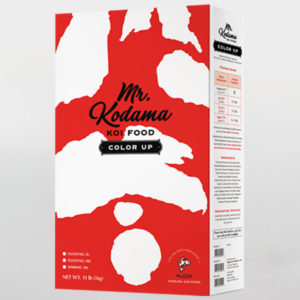 This food is designed to enhance the color and health of koi scales because it include high quality spirulina. Spirulina will also improve the immune system and flesh quality of your koi.
This food is designed to enhance the color and health of koi scales because it include high quality spirulina. Spirulina will also improve the immune system and flesh quality of your koi.
Benefits of Color Up include:
- Beautiful Scales
- More Vibrant Colors
- Boosted Immune System
- Noticeably Faster Growth
- Improved Health
- Easier & Smoother Digestion
For Beautiful Shine and Vibrant Colors: Mr. Kodama Koi Food – All Season Wheat Germ
All Season/Wheat Germ is formulated for maximum koi growth and health, and its digestibility will allow you to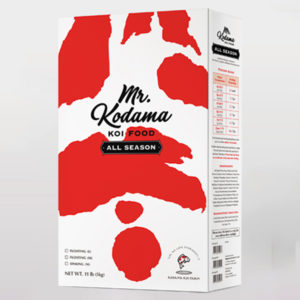 feed your koi all year round.
feed your koi all year round.
Benefits of All Season Wheat Germ include:
- Noticeably Faster Growth
- Improved Health
- Beautiful Skin
- More Vibrant Colors
- Easier & Smoother Digestion
For Growth and Enhanced White Skin: Hi Silk 21
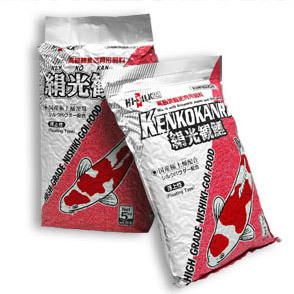 Hi-Silk 21 Koi Food is designed to produce beautiful sheen in the colors of Nishikigoi, especially the white of Nishikigoi.
Hi-Silk 21 Koi Food is designed to produce beautiful sheen in the colors of Nishikigoi, especially the white of Nishikigoi.
Benefits of Hi Silk 21 include:
- Noticeably Faster Growth
- Natural and Silky White
- High Quality Protein, Vitamins & Minerals
- Carefully-selected Raw Materials
- Packaged For Freshness
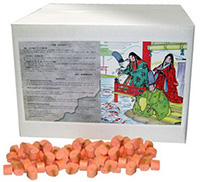 For Training, Low Temperatures, and Easy Digestion: Manda Fu Koi Treats
For Training, Low Temperatures, and Easy Digestion: Manda Fu Koi Treats
If you enjoy the time spent feeding and petting your koi, you will want to have Manda Fu on hand year round.
With the best digestion rate of 98.2%, Manda Fu is the most suitable koi food for autumn, winter and spring. You can feed your koi Manda Fu even when the water temperature drops as low as 45F to 50F degrees.
Benefits of Manda Fu include:
- Hand Feed Your Koi
- Enhanced Health
- Softer & Smoother Digestion
- Gorgeous Scales
- More Dynamic Colors
Discover premium Koi food nutrients and supplements by visiting our Koi Products and Supplies page:
Welcome to Kodama Koi Supply – Our family’s trusted
online store for Koi pond essentials!
Shop NowOr explore our selection of Koi food directly here:
Koi Food – Buy the Best Food for Your Koi Online
Browse Koi Food
There Are Human Foods that Koi Can Eat – Only as Occasional Treats…
You may have heard that some feed their Koi fruits and vegetables such as water melon, oranges and even cereals. I know Koi love them. Personally, I think it is OK to feed these foods to your Koi. The only exception to note is that cereals should only be fed as an occasional treat and you must clean out any leftovers.
Koi pellets are designed to complete the needed diets for Koi’s health and beauty. So as long as you feed proper Koi food, your Koi should be well with these additional treats.
Remember, human foods should just be additional treats.
You must clean out any leftover human treats!
Learn The Many Influencers of a Koi Diet
There are several factors to consider when feeding your Koi fish, most of which have to do with the Koi’s body and how the external environment affects their digestive tracts.
To understand how the influencers of your Koi’s diets work, first you must understand how the Koi’s metabolism and digestion are subject to these changes.
Koi Digestion 101: Koi Have No Stomachs and are Cold Blooded
Remember Koi do not have stomachs. This means that they cannot eat a lot all at once and store the food in stomach for digestion. They need to eat small amounts frequently.
We human beings have a stomach to temporarily store the food, so we can eat larger amounts and digest slowly. We don’t feel hunger for about 5 hours after the meal. However, Koi fish don’t have a stomach, so they feel full very quick. This is the reason why they are hungry all the time and they will want to eat little amount in different times.
Temperature plays a big role in assisting the Koi to digest food as well, as they are cold blooded creatures. The colder it gets, the slower your Koi’s metabolism and their metabolism will increase with heat. This is why during the summer time, that the Koi are always hungry and during winter temperatures the Koi’s ability to digest is impeded, therefore they will eat much less or not at all.
As you will find, there are so many extreme variables in feeding your Koi, which is why I love auto feeders. An auto feeder can do the guesswork for you to calculate the right amount of food based on the feeding schedule and temperature of the water. As you cannot always be near your Koi pond to monitor the following changing variables, having a safe and secure backup is paramount.
Koi Food Seminar Part 1 – Feed Your Koi the Right Way!
Continue Watching…🎥
Koi Food Seminar Part 2 – Our Feeding Process and What We Feed
Factors that Affect Koi Feeding Amount and Frequency
Here are some factors to consider when deciding how much and how often to feed your Koi. Based on the temperature, the size of your koi, and the water quality, you will soon come to an understanding of what feeding needs there are for your specific pond.
- Koi Fish Size – When your Koi are smaller, feed smaller portions of food. Our Manda Fu Koi Food can be broken down into smaller bits for hand feeding. A larger Koi will need more sustenance than a smaller or younger Koi fish.
- Season – Some locations undergo drastic seasonal/feeding changes, such as high heat in the summer and extreme low temperatures in the winter months. Other climates are much more temperate and may have more regulated feedings all year round.
- For example, our Florida Koi Store location will have a different feeding schedule than our New Jersey Koi Store location. For more details on how to deal with these different climates, please feel free to contact our stores that are closest to your climate.
- No matter what your climate, preparing your Koi pond for the spring still requires annual maintenance.
- Please remember Koi go into hibernation once winter comes. They spend the whole winter with no food. So they must eat and store nutrition as much as possible during the summer time. If they do not eat enough, at many times, they go into winter in poor health and that may result in sickness in spring.
- Temperature – Why is water temperature important to feeding Koi? This is because the water temperature determines what and how often Koi can eat.
- Please see the Feeding Chart for more instruction about feeding during different temperatures.
- Remember your Koi do not have stomachs and are cold blooded animals, so the ability to produce digestive enzymes in their intestines is dependent on temperature. Don’t risk your Koi’s life!
- Weather influencing Oxygen Content – Koi need oxygen for digestion. The less oxygen in your pond, the less that your Koi can digest food. Some recommend that you do not feed Koi during or right after a storm, as the oxygen in the water is very low at this time. Whenever your Oxygen is low, you should feed your Koi less.
- Water Quality and Pumps affecting Oxygen Content – Please do not forget that when Koi fish eat more, they poop more. During feeding season, please monitor not only water temperature, but also water quality. Always keep your water parameters within the healthy range.
- Again, if the oxygen content drops in your water, your Koi will not be able to digest to the best of your ability. If your pump also fails to work, then you will encounter the same problem. You must make sure the water quality is correct or else your Koi may become sick or unable to digest food properly. We will discuss water quality in more detail in another blog.
How Much Do I Feed My Koi?
The safe amount for Koi to eat per feeding is said to be the amount of food that they can finish in about 5 minutes.
I usually recommend customers to feed the amount Koi can finish in 5 – 10 minutes. if you see any leftover, please scoop them out. If you leave uneaten food in the water, it will end up ruining your water quality.
Earlier we mentioned that temperature plays a big role in assisting the Koi to digest food as well, as they are cold blooded creatures. Remember this fact and you will be successful at adjusting your Koi’s feeding schedule:
Cold impairs and heat speeds up your Koi’s digestive ability. This is why Koi eat more in the summer and less (or nothing) in the winter.
At Kodama Koi, we analyze the parameters of our Koi gardens to ensure the correct feeding schedule. Are you ready for the inside scoop on how a champion is fed?
Kodama Feeding Chart: When do we feed and how often?
I think the below chart is helpful to answer this question. This chart uses Kodama Koi food and other popular Japanese Koi food as examples. The frequency is conservative. If you would like to push the growth of your Koi, you may be more aggressive. Each Koi food brand usually has a recommended water temperature located on the package to ensure you choose the right amount.

To maximize Koi growth, feeding as often as recommended at each water temperature zone is very important because it is only a small amount of food for each feeding.
You Can’t Always Be There To Feed Koi, But An Auto Feeder Can!
Any connoisseur knows that, in feeding Koi, consistency is the key!
We eat breakfast in the morning, lunch at noon and dinner in the evening. And, we usually eat each meal at about the same time. I believe that Koi are smart. They learn who feeds them and when. And they expect food when they think they should be fed. So to maximize the benefit of their diet, please be consistent at what time to feed your Koi.
If you decide to feed your Koi at 7 am before you go to work, and 7pm after you come home, keep a consistent daily routine for your Koi.
It is not a good idea to take an emergency appointment and forget to feed the koi, no matter how important the meeting is, have a plan of action to keep the routine consistent.
After reading this article, you will know there are many factors that influence your Koi’s diet. There are benefits to having an auto feeder as a support to your Koi’s normal routine, while we don’t mean to make you more paranoid about your Koi’s health while you are not around.
This invaluable device can mimic your presence and will give you the peace of mind that your Koi are being fed and monitored to the best or your analytical ability, even while you are on vacation.
All Koi Breeders in Japan use Auto-Feeders
So, we return to the first question in this article: Who feeds your Koi at lunch? I bet most of you reading this work outside of your homes. Few have the luxury of coming home at lunch and feeding your Koi around noon. For that reason, I usually recommend automatic Koi feeders.
With auto feeders, not only can you feed your Koi around noon, but also you can also feed them as often as you want – whether you are around or not. Your Koi will get the food exactly the same amount of food at the same time every day – which is the ideal circumstance for growing healthy, happy Koi.
Additionally, if you live in the area where the water temperature falls below 50 during winter, it is critical you that you feed your Koi as much as you can before that shift happens – so that they can hibernate for a long and healthy winter.
There are several auto feeders on the market, but I love the one from Japan “Esayari Meijin” or Feeding Master in Japanese. All the breeders in Japan use this one. At my farm in Hawaii, I use them for most of my 80 ponds. I love this device and I recommend this to many of my customers for several reasons.
Benefits of an Auto Feeder
There are many benefits of the auto feeder that I personally recommend:
Put it Anywhere – Solar or Electric Powered
First of all, it comes either with solar power or a power cord. So you really do not need power supply by your pond. There are no restrictrictions for where you must put your feeder.
It is Easily Programmed for Scheduled Feedings
Also, it can program up 12 feeding per day. And, at each feeding, you can program how wide, how far, and how many seconds (how much food) this feeder will shoot out.
It Supports Your Hand Feeding Relationship with your Koi
Even with an auto feeder, I do recommend you should feed by yourself at least once a day. Having an auto feeder is great, but it should serve as a “peace of mind” when you cannot be present to hand feed.
Remember, hand feeding is an important tool for Koi care, as it helps you monitor their behaviors and check their health. More than anything, it helps the Koi to feel your care.
Achieve Consistency and Peace of Mind
The last great benefit of an auto feeder is that you can feed your Koi as frequent as you want, even while you are not at home.
Want to go on a vacation in the Bahamas? Auto feeder. Sudden illness befalls? The auto feeder is in place. Never worry that you cannot check the parameters of your pond to ensure the health, growth, and color of your prized living jewels. Leave that to the auto feeder.
How Automatic Koi Feeder Works
Don’t Ask a Friend To Help, When You Can Invest in an Auto Feeder!
In this busy lifestyle, there is nothing more paramount than peace of mind with your Koi fish. Nothing zaps your energy more as you are enjoying the other areas of your life than the worry you may have for your Koi fish when you cannot be present.
I highly recommend this Koi Auto Feeder as I use them daily on my Koi farms. You can feed your Koi as frequent as you want, especially while you are not at home. Maximize the growth, color and health of your Koi everyday by supplementing your feeding schedule with an auto feeder.
As a serious hobbyist, having an auto feeder by your side really steps up your game and reduces your worry.
Learn more about how the Automatic Koi Feeder monitors the parameters of your pond for the perfect feeding schedule.
Looking for quality koi? Visit our koi farm site online to view our best Live Koi Fish for Sale
Solar Koi Feeder
This Solar Koi Feeder can save you time and is powered by the sun for even more convenience. Set your feeding times and amounts, put your koi food in it (up to 15 lb), and let it take care of the rest.
Automatic Koi Feeder
5 Benefits of Hand Feeding Your Koi Fish & Petting Tips
Petting and hand feeding koi fish allows you to engage with these vibrant and graceful swimmers in a whole new way, while also enjoying a calming and therapeutic experience. In this article, we will dive into the world of koi fish and explore the art of hand feeding and petting them. We’ll cover the benefits and precautions for you to get started hand feeding your koi.
Read more about Hand Feeding Koi
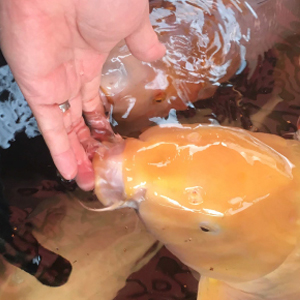

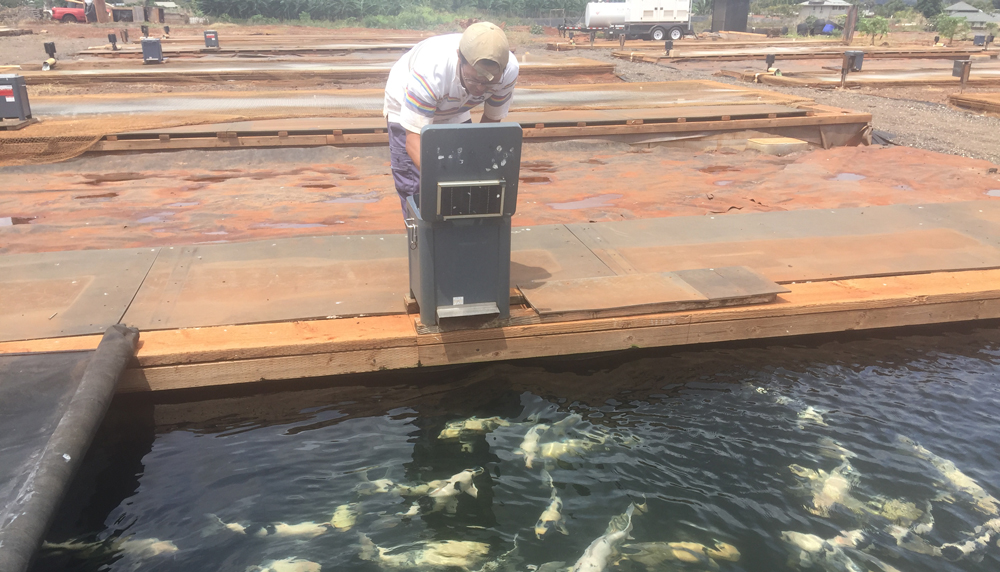
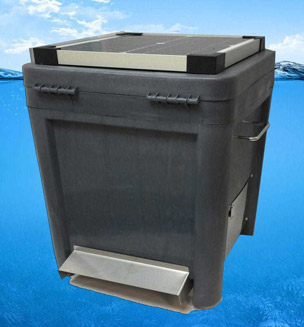
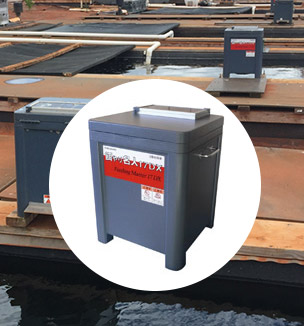
I see the chart but if intbe day it’s 70 andat night 45. What would you recommend as far as feeding
Hi, that is a huge gap in one day. I would still feed but very conservatively during day time.
We have a significant amount of algae growing in our small pond. Our pond is about 10’ x 8’ x3’ deep. We have six nice Koi about 6-8” long. Our feed store said the Koi will survive on only the algae and natural food the pond produces. Is there any truth in that?
Hello, I do not think so. I am not sure what they mean by “natural food that the pond produces.” Koi will eat algae. Koi will eat whatever available in the pond. Koi will probably survive for months without you feeding them. But I do not think it is a healthy life for your Koi.
I have only been feeding my Koi once a day in the early evening. They seems to be thriving. I also see them eating the algae off the rocks in the pond. Do I really need to feed more than this?
Hi Mary
If you live in an area with winter where Koi has so many months with no food, Yes, I would suggest you feed more. They need to eat as much as they can to store the energy to spend the whole winter. Of course, this is so as long as your filter can handle the waste load.
can u feed at night
Hi Debra
Of course. A breeder I know feed even at 2am. When you come back home from work, please sit by your pond, relax and feed our Koi at night. It is such a precious moment.
I have a male 3spot blue gourami named [KINGBLUE🔵👑] a female 3spot blue gourami named (princessblue🔷️💙) 3 blackskirt tetra and 1 single grumpy redstate republican🚩 male firemouth cichlid named {professor Orbon} 😊
Several of my koi have white ulcer looking things on them that looks like a cotton ball what treatment for that?
Why does baby koi doesn’t eat food day 3
Hello, I am sorry I am not sure if i understood your question. Can you give me more info?
I have an indoor pond, Approx 50 Gal. Only one Koi. There used to be more but Charlie kills any other fish I try to introduce into his pond. I’ve been feeding him goldfish flakes all his life. I’ve had him for 15 yrs now. I’ve tried pellets, he doesn’t like them. I have tons of earthworms in the spring and summer. I’m just curious about introducing him to live food other than other goldfish or Koi. Since the pond is indoors the water temp stays the same year round. He doesn’t hibernate. I’ve been feeding him once a day, should I feed less more often?
Thank you. I am curious why the Koi kills others. Koi in nature is very friendly Koi and I don’t usually see a koi kills others. Introducing natural food should be OK. About the frequency and the volume of Koi food, if once a day has been working for the last 15 years, I would suggest you stick with it.
Hi, can I please get to know how much grammes of food needed by a 5-year-old Koi which is about 3 to 4 feet long?
Hello, thank you very much for your question. It really depends on what you want to do with the Koi and what kind of food you feed.
3 feet Koi are about 12kg (about 26.4lb). if water is above 70f, 1% of Koi weight, 0.26lb, is about what you can feed a day.
I am getting 2 tosai from your farm. What should I feed them?
Sorry for the late reply. Is your water is warm enough like 55 F, please start feeding them, but slowly please. Please follow the feeding charge above.
Thank you your feeding guide – I found it very informative. You seem to be saying that we should feed wheat germ based food all year and higher protein, harder to digest foods, in addition, when it get warmer. Is that correct? Also recently, I’ve been feeding hi-silk 21 along with other foods and was surprised to see it not mentioned. Assuming a mix of hi-silk 21 with the other foods you mentioned approx how many feedings of each would you suggest each day for max growth (water temp 75 F)? Lastly can you please comments on using floating verses sinking pellets?
Glad to hear you found it informative.
You can feed wheat germ based food (I think most of the high end food are wheat germ base) all year around. Once water is warmer, you can feed color food and groth food like Hi Silk.
Yes, Hi Silk is a very good, reputable food in Japan. My father designed the food with Kawaguchi Shoten Co., Ltd. You can find out more about Hi Silk at https://www.kodamakoigarden.com/koi-food-guide/
Regarding the frequency of feeding, it really depends on your filter capacity. Feeding more means more wastes. Please make sure your filter can handle the load. If it can, I would say 5 times should be sufficient.
About floating vs sinking,
it is your choice. To maximize the growth, sinking does better job because Koi are bottom feeder. With floating food, you can enjoy feeding and observe their health better.
Loved Your Article. How is dried silkworm Pupae for Koi ? It is used as snacks for them. High in protein & good amino acid profile. What is your view ?
Thank you for your comments. Silk worm pupea is great for Koi too. One thing you have to be careful is the freshness. You never know how old the silkworm is when you buy them. so if you have access to silk worm, make sure you get them from reliable source for your Koi
I have an Olympic++ size natural pond full of all sorts of water bugs, natural grasses etc and many small leeches. Would koi be able to live on the natural plants and leeches and bugs? The pond goes to 14 feet deep, spring fed. I have never used this site before
Hi Andrea, breeders raise Koi in natural ponds during summer. So you should have no problem.
Could koi live in a natural spring fed large pond
Yes
Yes
I have canned crickets. Can I feed them to Koi?
Hello, I think so. I have not done it personally. But they eat those bugs in nature while they are in mud ponds. So I believe you can
I want to order food for the koi fish but you show there are different food choices. I live in Dallas and I have 10, 8-9 inch koi fish and the size of the pond 1,500 gallons. I want to know which one is better for the size of the pond and the 10 koi fish?
Hi Juan, because you have only 10, 8″ Koi, you do not need a big bag. I would suggest you should start with Kodama Koi Food All Season 5lb (Medium pellets). https://www.kodamakoisupply.com/kodama-koi-food-all-season-wheat-germ/
Hello!
Thank you for article! It has helped me a lot 🙂 Due to a “happy accident” I ended up adopting 3 koi fish. I don’t have much experience with big fishes. I was wondering of you could provide some insight
I live in Costa Rica -pretty tropical weather. So am not worried about freezing temperatures or anything below 20C. What am worried about is that I’ve read that I shouldn’t feed the fishes during rains but when the rainy season comes in, we usually get days of non-stop rain. how would feeding work on those days?
I am glad our blog is helpful. It is a very difficult questions. During the rainy season, I do not think you should stop but you should be very conservative in feeding. It means you should feed less. The rain could affect water temp and water quality very much. When water temp and quality are not stable, it causes stress Koi. When Koi are stressed, if we feed Koi too much, it makes Koi sick.
Is there an automatic feeder for pond use?
Hello, yes there are. Please check these 2 products.
https://www.kodamakoisupply.com/solar-koi-feeder/
https://www.kodamakoisupply.com/automatic-koi-feeder/
Hi John yes there are.
Please find the link in the blog. For any questions on the feeder, please contact us at info@kodamakoifarm.com
Hi I am a new koi pond owner. I just built 2- 10’x20′ ponds on my property in mt. View, hi. They are about 3′ deep. Currently only have one koi but planning on 4 per pond. Any recommendations on feeding amounts and schedule for the 4 koi per pond? Mahalo!
Hi John, For detail, it is probably the best you call us at 1-844-KoiLove. But in general, feed them so that they can finish eating in 5-10 min. 2-3 times a day. Are you from Hawaii?
Hi, I live in tropical area with temp around 86f all year round. Have been feeding koi 3-4 times per day, do I have to fast the koi once a week to clear their guts?
Some hobbyists may fast Koi. But at our farm in Hawaii, for the ponds where we want to grow big, we will not stop feeding.
My baby Koi carp, about 2-4 inches, enjoy eating peanut butter, banana, and cilantro as treats. How often can I give them these? Multiple times a day or one in a few days? Please help!
Hi I am sorry I do not know if these are nutritiously good or not. So I would not recommend them.
Hi Taro
i have a 2000 gallon backyard Pond approximately 2 and half feet depth in Vietnam. how many Koi fish can i fit in for optimal growth? right now i only have 5 Koi, how many more koi can i fit in there. Btw, do you guys ship to Vietnam? i have another technical question here, I am in Saigon, the climate here with temperature above 30C all year around. right now i feed them Hi protein food from jan to August to grow size, and low protein color enhancer from September to December to have them grow colors. i found this piece of information online but do not know if feeding this way make sense to you.
Thank you
Elson
Hi Taro Komada. I live in the North of Vietnam. It is summer now, the temperature is 35 -36 degrees Celsius. My Koi are 40-45 cm. Because I am busy with work, I feed Koi 4 times a day (7 a.m, 11 a.m, 5 p.m and 9 p.m). I am using HIKARI WHEAT GERM bran, size L. Is it appropriate for me to feed like that? Should we feed the Koi at 9 p.m? Should we soak the sprouted paddy and feed the fish more often? Thanks.
Hello, if you are from Vietnam, please contact our distributor of our Koi Food. They are Koi world.
http://thegioicakoi.vn/
Koiworld2020@gmail.com
0274 3777 558 – 0913 988 895 (Mr. Mihn)
Good day to you sir, how can I maximize koi growth? How many times should I feed them everyday? Thank you.
What is the best food to feed 4 to 5 inch koi carp.
Hello, Thank you for your comment. We feed Kodama Koi Food in mini pellets.
Can we feed super worm on our koi?
Hi, I have purchased a number (not all) of koi from Kodama Farms. I love them. I have 25 koi, sizes from 9” to 20” – and one little 6” from somewhere else (quarantined for a long time before introduced) I feed the colorup (large and medium), hi silk, manda fu and just got some kodama sinking. Reason being the larger koi are more aggressive and get more food. My fear is most of the food. I have started soaking the food so I am a better “shot” to get food to the smaller fish and it sinks so they can get to it before the little piggies get there. I say little piggies because several of them seem to be getting heavy around the abdomen. They are indoors, 8000 gallon pond, 73 degrees, water parameters are good and I think I am feeding within the guidelines. I do not think there are any illness issues.
1. Is it ok to soak the food before feeding?
2. Am I feeding too much given some of the fish are less svelte now? I think they are too young to be “expecting “ – the ones who have bellies are about 12 – 13” and born in 2020. The very large girls are not tubby.
Thank you.
Hi Gabrielle,
I thank you so much for being a loyal customer of Kodama Koi Farm. I am happy our Koi found a very nice home at your place.
To your questions,
it is OK to soak the food, but please make sure your Koi eat them right away. If they are left uneaten, they will be dissolved into water and dirty your water quick.
for the second question, it is hard to answer without seeing your Koi.
please send the pictures of your Koi to sales@kodamakoi.com
Stay happy with your Koi
Thank you
Can you feed your Koi dried shrimp and dried grubs